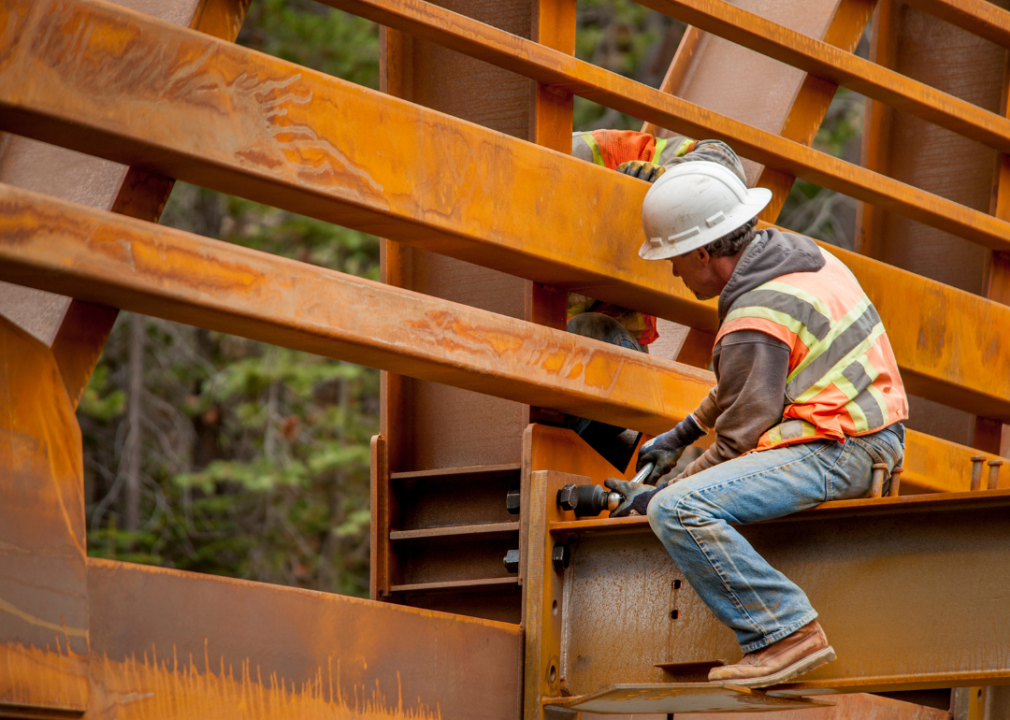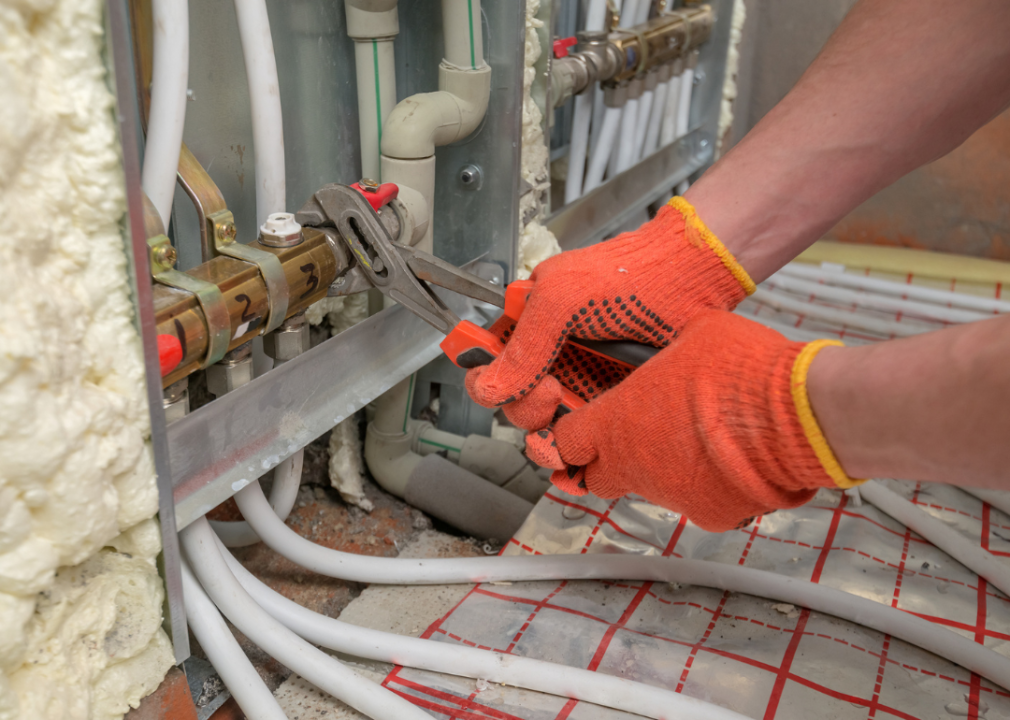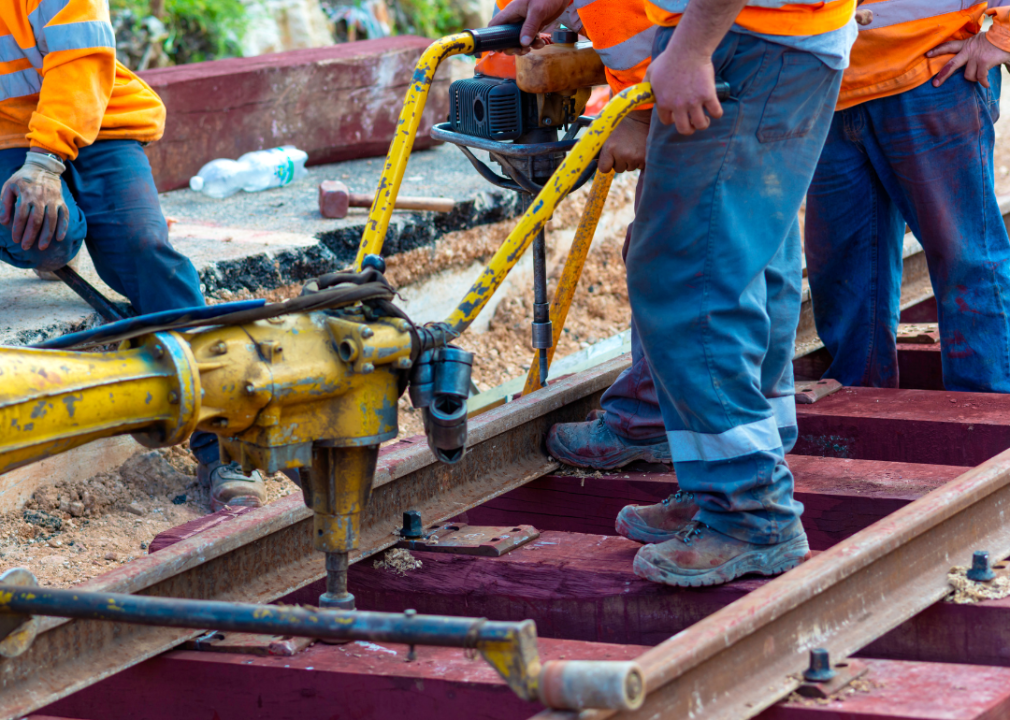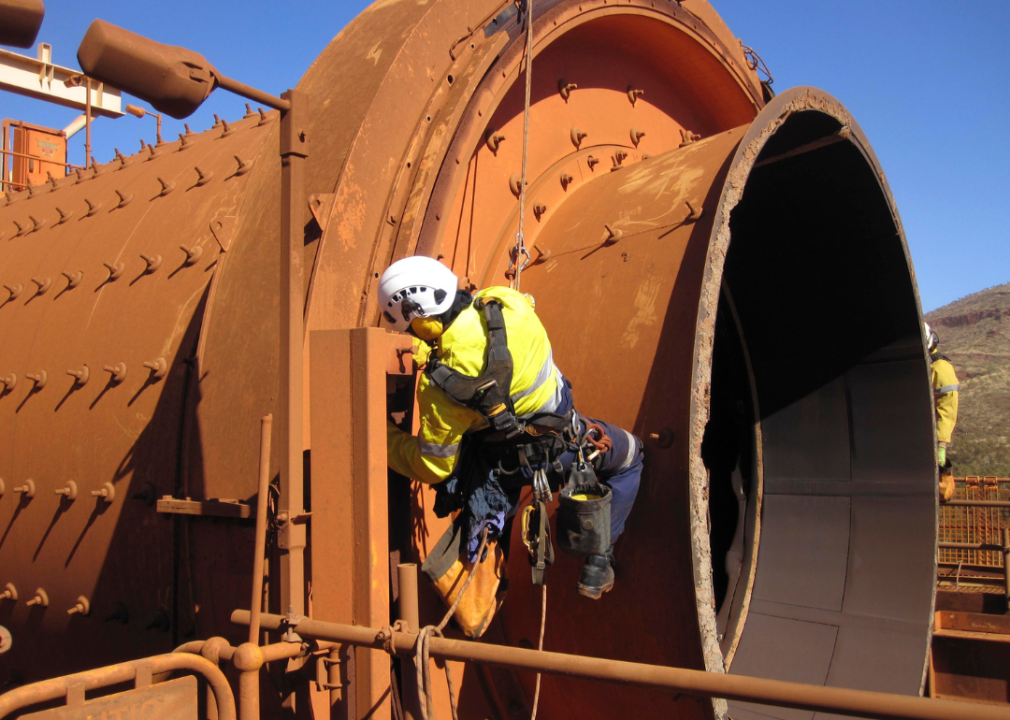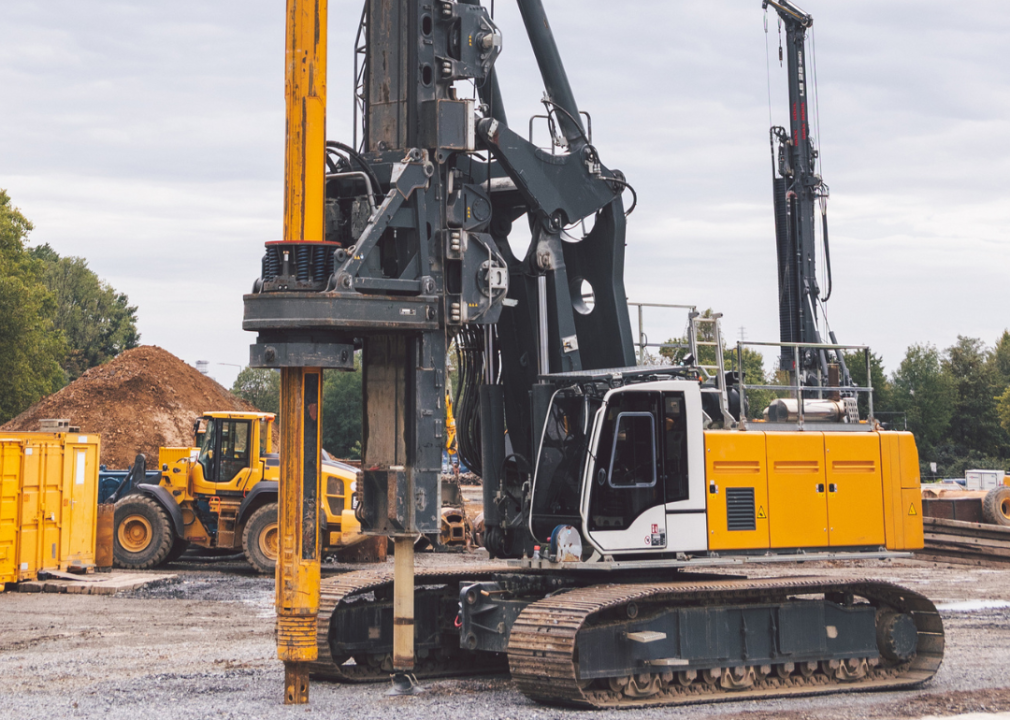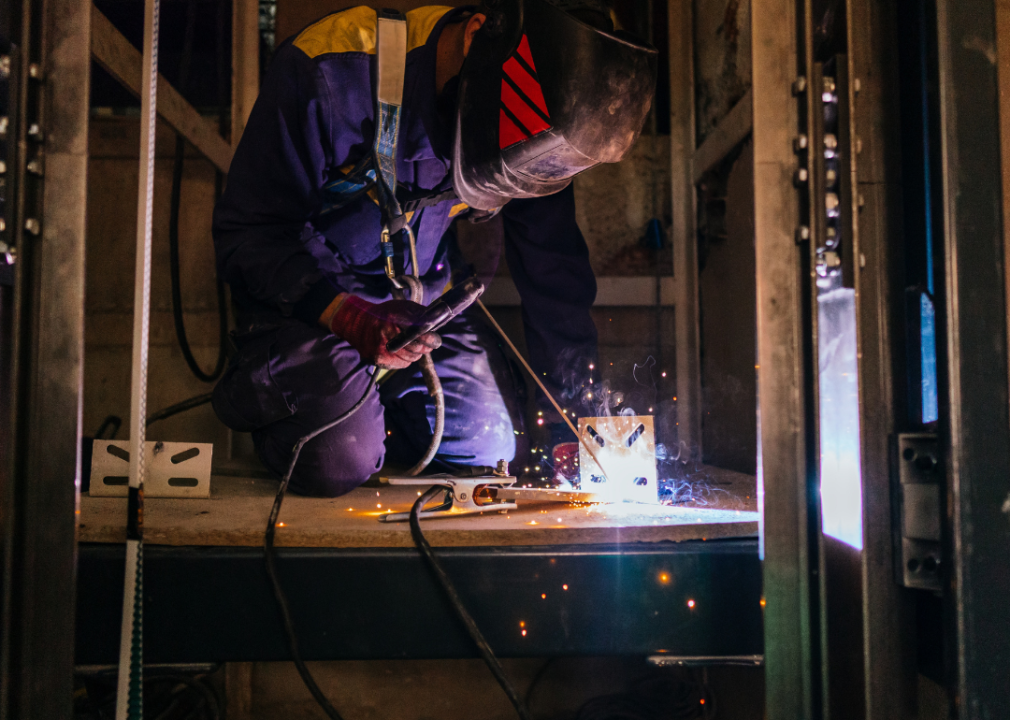Business
These skilled trades jobs pay more than $50K
Published
1 year agoon
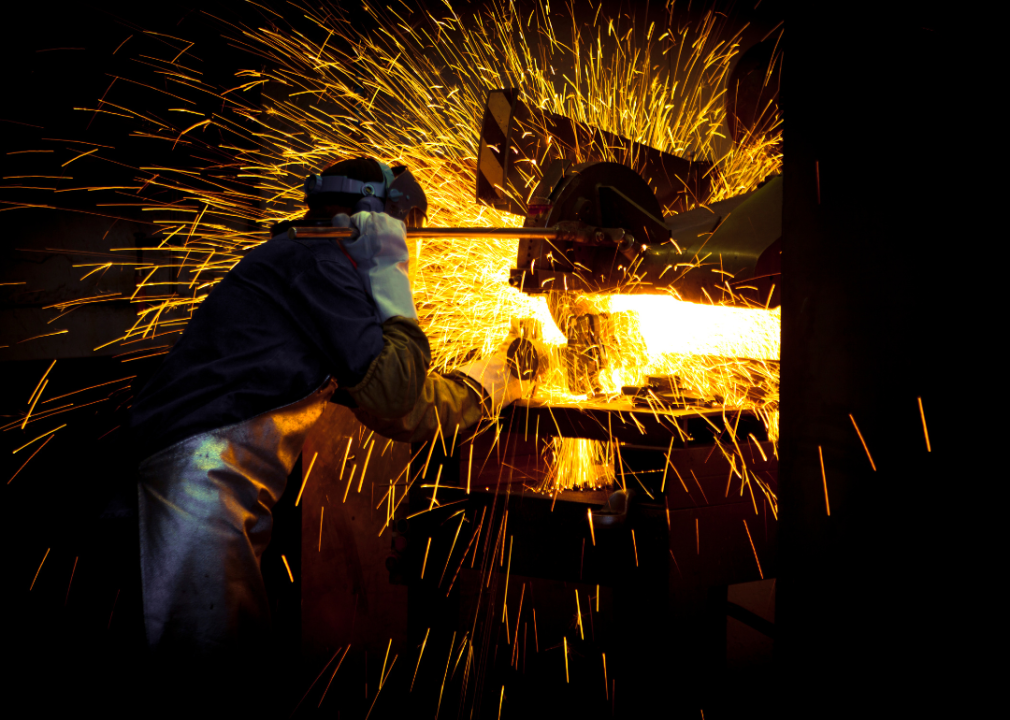
When the COVID-19 pandemic began and people were suddenly spending more time at home, many started looking at repairs and renovations they’d put off. For employers and commercial building owners, having fewer workers in the office made it an ideal time to schedule renovations and other structural improvements without disrupting business. Though the timing seemed right to address such issues, obstacles presented themselves: supply chain hiccups and a shortage of workers in skilled trades.
Between the housing market upswing and infrastructure advances, employment opportunities exist in the residential, commercial, and government sectors. When looking at salaries for these jobs, ServiceTitan examined 2021 data from the Bureau of Labor Statistics. The U.S. Census Bureau reported the median annual wage for jobs in skilled trades is $56,287. Most of these professions don’t require a costly investment in higher education, instead depending on apprenticeships and on-the-job training.
This list includes the top 10 skilled trade jobs within this target salary range. Below is information about each position, potential areas of expertise, an overview of the education and training typically required for each trade, as well as the projected employment growth from 2020 to 2030.
![]()
Canva
Sheet metal workers
– Median annual wage in 2021: $53,440
– Typical education needed for entry: High school diploma or equivalent
– Typical on-the-job training needed: Apprenticeship
– Projected employment change (from 2020–30): 3.6%
Sheet metal workers fabricate, install, and maintain thin steel aluminum and alloyed metal sheets. Most commonly, sheet metal workers can be found in manufacturing, infrastructure, and construction fields. Heating, ventilation, and air conditioning ducts, home exterior siding, metal lagging of mechanical systems, and outdoor signage are just a few types of jobs sheet metal workers tackle.
There are several specializations in sheet metal work. Those in fabrication—or precision sheet metal workers, also known as metal and plastic machine workers—make parts for various industries. This often finds them using computer-aided drafting and design systems, lasers, and automated machinery.
Contributing to the 3.6% rise in sheet metal worker jobs forecast through 2030 are changes in the housing market and U.S. investments in infrastructure. Additionally, new energy-efficient equipment coming to market will lead to increased calls for installation work. New technologies, such as prefabricated duct systems in residential construction, could hinder these numbers from rising higher.
Canva
Structural iron and steel workers
– Median annual wage in 2021: $58,550
– Typical education needed for entry: High school diploma or equivalent
– Typical on-the-job training needed: Apprenticeship
– Projected employment change (from 2020–30): 5.9%
Ironworkers are involved in the construction, rehabilitation, reinforcement, and even demolition of bridges, roads, and buildings.
Structural iron and steel workers erect structural frameworks using levels, lasers, tag lines, and plumb bobs, then join them with bolts, wires, and welding. Ironworkers assemble the cranes and derricks used on these building sites, too.
With the U.S. focusing on infrastructure improvements to structures such as old bridges and highways, ironworkers are set to see a 6% increase in demand between now and 2030. A surge in growth was first noticed during the recovery from the COVID-19 recession in 2020. The U.S. Environmental Protection Agency is currently planning water infrastructure efforts using State Revolving Funds, which will call for ironworkers. However, special tying and placing equipment entering the market could hinder growth in the future.
Canva
Brickmasons and blockmasons
– Median annual wage in 2021: $59,340
– Typical education needed for entry: High school diploma or equivalent
– Typical on-the-job training needed: Apprenticeship
– Projected employment change (from 2020–30): -5.3%
Masonry workers, or masons, use brick, stone, and concrete in the construction of everything from buildings and dams, to walkways and roads.
Expertise is often based on the materials used. Brickmasons, also known as bricklayers or blockmasons, use materials including brick, terra cotta, and concrete blocks to construct and repair structures. Refractory masons specializing in high-temperature work with furnaces, fireplaces, and industrial sites, also fall under this category. Taking on detailed work are cement masons and concrete finishers who prevent defects in sidewalks, walls, columns, and other structural components made from concrete.
Granite, marble, and limestone are various types of stone materials that fall under the expertise of stonemasons, who use them when building structures and other surfaces. Floors, walkways, and patios are also created by terrazzo workers and finishers, or terrazzo masons. There is some crossover in their skills with that of cement masons.
Changes in materials and installation practices are projected to decrease the need for masons of all types of expertise in the future.
Canva
Plumbers, pipefitters, and steamfitters
– Median annual wage in 2021: $59,880
– Typical education needed for entry: High school diploma or equivalent
– Typical on-the-job training needed: Apprenticeship
– Projected employment change (from 2020–30): 5%
Though they may use different approaches or techniques, plumbers, pipefitters, and steamfitters all install, inspect, test, repair, and maintain pipelines, piping systems, and fixtures used to convey water, gas, and other substances.
Depending on the materials they use, plumbers, pipefitters, and steamfitters may specialize in either residential (copper, steel, and plastic pipe materials) or industrial projects (large steel pipe materials).
Plumbers, who are considered journey- or master-level depending on their training and experience, fall into the residential category and primarily deal with water, gas, and piping systems for homes and businesses. Pipefitters and steamfitters (or fitters) specialize in systems found in industrial, manufacturing, and commercial industries, which may carry chemicals, acids, and gases.
The projected 5% growth in employment for plumbers, pipefitters, and steamfitters is based on the 2020 recovery from the COVID-19 recession, which brought an influx of new construction. There is also an increased call for sprinkler fitters as states update building codes for fire suppression systems.
Canva
Electricians
– Median annual wage in 2021: $60,040
– Typical education needed for entry: High school diploma or equivalent
– Typical on-the-job training needed: Apprenticeship
– Projected employment change (from 2020–30): 9.1%
Think of an electrician’s duties, and the mind generally goes to installation, maintenance, and repairs of equipment and control systems, specifically those for the electrical power, communications, lighting, and wiring found in homes, businesses, and factories.
Many electricians, however, begin their work before installation takes place. Experienced electricians are often called to join a team of architects and engineers when they design a new electrical system. Another area of expertise can be seen in the work of lineman electricians, who install distribution and transmission lines.
What’s on the horizon for electricians? Currently, there are projections for 84,000 job openings per year. As the U.S. government explores alternative sources of power, the field should continue to expand, as electricians will be required to link solar and wind generators to power grids and homes.
In August, the government’s passage of the Inflation Reduction Act was applauded by the National Electrical Contractors Association, which pointed to the $369 billion investment in domestic energy production and manufacturing that “will provide NECA contractors with new opportunities to modernize our energy portfolio and create good-paying jobs across America.”
Canva
Tapers
– Median annual wage in 2021: $61,080
– Typical education needed for entry: No formal educational credential
– Typical on-the-job training needed: Moderate-term on-the-job training
– Projected employment change (from 2020–30): 0.5%
Tapers, or finishers, prep wallboard for paint or wallpaper. They also repair damaged wallboard. Often, tapers work in conjunction with drywall and ceiling tile installers. Drywall installers, known as drywallers or hangers, cut and hang wallboard. Ceiling tile installers, or acoustical carpenters, install tiles to ceilings to block sound. Many tapers perform all three skills on their own.
Future employment growth for drywall and ceiling tile installers is projected to remain steady, whereas that for tapers looks to decline due to new tools hitting the market.
Canva
Construction and building inspectors
– Median annual wage in 2021: $61,640
– Typical education needed for entry: High school diploma or equivalent
– Typical on-the-job training needed: Moderate-term on-the-job training
– Projected employment change (from 2020–30): -2.9%
Before work at a site even begins, construction and building inspectors enter the scene to review plans. Their presence continues as construction progresses, whether it be of a home, building, highway, dam, or bridge. Their eagle eyes, and a bevy of tools, ensure everything is compliant with the latest building codes, zoning regulations, and any other ordinances.
Many inspectors have specialties. Architectural requirements and structural quality fall under the purvey of building inspectors. Fire inspectors make sure buildings meet fire codes. Coating inspectors keep an eye on the proper application of protective layers of exterior paint and coatings used on everything from bridges to pipelines. Others specialize in electrical systems, elevators, residences, mechanical systems, plumbing, public works, and construction.
So why will there be a decreased demand of -2.9% for inspectors in the future? The government’s use of remote inspections.
Canva
Rail-track laying and maintenance equipment operators
– Median annual wage in 2021: $61,690
– Typical education needed for entry: High school diploma or equivalent
– Typical on-the-job training needed: Moderate-term on-the-job training
– Projected employment change (from 2020–30): 5.3%
This profession has many titles ranging from machine operator and track inspector to track walker and, simply, trackman. Also falling under this category are ballast cleaning machine operators and railroad bed tamping machine operators.
These workers lay, repair, and maintain track for railroad service, be that in commuter service, plant yards, quarries, mines, or pits for sand and gravel.
As of 2020, 15,700 workers held these positions. New jobs expected between now and 2030 come in at a scant 800.
King Ropes Access // Shutterstock
Boilermakers
– Median annual wage in 2021: $64,290
– Typical education needed for entry: High school diploma or equivalent
– Typical on-the-job training needed: Apprenticeship
– Projected employment change (from 2020–30): -1%
Boilermakers specialize in keeping boilers, tanks, and vats that hold chemicals in efficient—and safe—working condition. This equipment is typically found in buildings, factories, and ships, and boilermakers must conduct tests and inspections to ensure worker and environmental safety.
It’s critical to assemble and maintain this machinery against defects because they’re often heating liquids or gases under extreme pressure. A boilermaker could be called upon to repair blast furnaces, inspect water treatment plants, or install heat-resistant materials in high-pressure tanks.
Boilers are generally built to have long lifespans, but boilermakers are often called on for repairs. So why the -1% projected decline for the profession? The U.S. is shifting to renewable energy, much of which does not require boilers.
Canva
Pile driver operators
– Median annual wage in 2021: $76,260
– Typical education needed for entry: High school diploma or equivalent
– Typical on-the-job training needed: Moderate-term on-the-job training
– Projected employment change (from 2020–30): 4.8%
Working with heavy-duty pieces of equipment, pile drivers hammer steel, concrete, and wood pilings into the ground, or in some cases underwater, most often in the early stages of construction of retaining walls, bulkheads, and foundations of structures. Workers manning pile drivers might be found doing so from skids, barges, crawler treads, and locomotive cranes.
United Brotherhood of Carpenters pile drivers have expertise vital for working with marine construction and offshore wind projects, which are significant in scope. A job requirement that may come into play is commercial diving.
Looking to break into pile driving? One place to start is by looking at the states with the highest employment of pile drivers: California, Washington, Florida, Louisiana, and Tennessee. Explore industries that regularly hire pile drivers, such as highway, street, and bridge construction, mining, as well as nonresidential building construction.
miguel curiel mena // Shutterstock
Elevator and escalator installers and repairers
– Median annual wage in 2021: $97,860
– Typical education needed for entry: High school diploma or equivalent
– Typical on-the-job training needed: Apprenticeship
– Projected employment change (from 2020–30): 6.1%
Elevator and escalator installers and repairers, also referred to as elevator and escalator constructors or mechanics, install, maintain, repair, modernize, and replace equipment such as elevators, escalators, chairlifts, and moving walkways. Working with electronics, electricity, and hydraulics is required for most of these positions.
The employment outlook for elevator and escalator mechanics is forecast to grow along with the influx of new development of nonresidential buildings. The typical lifespan of an elevator is 25 years. This means buildings with older equipment will need to repair, maintain, and replace equipment to meet American Disability Act requirements.
This story originally appeared on ServiceTitan and was produced and
distributed in partnership with Stacker Studio.
Founded in 2017, Stacker combines data analysis with rich editorial context, drawing on authoritative sources and subject matter experts to drive storytelling.
You may like
Business
Cashiers vs. digital ordering: What do people want, and at what cost?
Published
2 days agoon
April 26, 2024
You walk into a fast-food restaurant on your lunch break. You don’t see a cashier but instead a self-service kiosk, a technology that is becoming the new norm in eateries across the country. The kiosks usually offer customers a menu to scroll through and pictures of meals and specials with prompts to select their food and submit their payment in one place.
Self-service kiosks are big business. In fact, the market for self-service products is expected to grow from a $40.3 billion market value in 2022 to $63 billion by 2027, according to a report from BCC Research. Consumers do have mixed opinions about the kiosks, but about 3 out of 5 surveyed consumers reported that they were likely to use self-service kiosks, according to the National Restaurant Association. The technology, while expensive, can boost businesses’ bottom lines in the long run.
Task Group summarized the rise in digital ordering over the past couple of years, its acceptance among customers, and a cost analysis of adopting the technology.
Self-service kiosks—digital machines or display booths—are generally placed in high-traffic areas. They can be used for different reasons, including navigating a store or promoting a product. Interactive self-service kiosks in particular are meant for consumers to place orders with little to no assistance from employees.
The idea of kiosks isn’t new. The concept of self-service was first introduced in the 1880s when the first types of kiosks appeared as vending machines selling items like gum and postcards. In the present age of technology, the trend of self-service has only grown. Restaurants such as McDonald’s and Starbucks have already tried out cashierless technology.
From a business perspective, the kiosks offer a huge upside. While many employers are looking for workers, they’re having a hard time finding staff. In the midst of the COVID-19 pandemic, employers struggled with a severe employee shortage. Since then, the problem has continued. In 2022, the National Restaurant Association reported that 65% of restaurant operators didn’t have enough workers on staff to meet consumer demand. With labor shortages running rampant, cashierless technology could help restaurants fill in for the lack of human employees.
The initial investment for the kiosks can be high. The general cost per kiosk is difficult to quantify, with one manufacturer estimating a range of $1,500 to $20,000 per station. However, with the use of kiosks, restaurants may not need as many cashiers or front-end employees, instead reallocating workers’ time to other tasks.
In May 2022, the hourly mean wage for cashiers who worked in restaurants and other eating establishments was $12.99, according to the Bureau of Labor Statistics. Kiosks could cost less money than a cashier in the long run.
But how do the customers themselves feel about the growing trend? According to a Deloitte survey, 62% of respondents report that they were “somewhat likely” to order from a cashierless restaurant if given the chance to do so. The same survey reported that only 19% of respondents had experience with a cashierless restaurant.
What would it mean for society if restaurants did decide to go completely cashierless? Well, millions of positions would likely no longer be necessary. One report suggests 82% of restaurant positions could be replaced by robots, a prospect making automation appealing to owners who can’t find staff to hire.
Due to the ongoing labor shortage, employers have tried raising employee wages. Papa John’s, Texas Roadhouse, and Chipotle were among the restaurant companies that increased employee pay or offered bonuses in an attempt to hire and retain more workers. Meanwhile, some companies have decided to use technology to perform those jobs instead, so that they wouldn’t have to put effort into hiring or focus their existing staff on other roles.
Story editing by Ashleigh Graf and Jeff Inglis. Copy editing by Tim Bruns.
![]()
Founded in 2017, Stacker combines data analysis with rich editorial context, drawing on authoritative sources and subject matter experts to drive storytelling.

It’s well-documented that the surest, and often best, return on investments comes from playing the long game. But between stocks and real estate, which is the stronger bet?
To find out, financial planning firm Wealth Enhancement Group analyzed data from academic research, Standard and Poor’s, and Nareit to see how real estate compares to stocks as an investment.
Data going back to 1870 shows the well-established power of real estate as a powerful “long-run investment.” From 1870-2015, and after adjusting for inflation, real estate produced an average annual return of 7.05%, compared to 6.89% for equities. These findings, published in the 2019 issue of The Quarterly Journal of Economics, illustrate that stocks can deviate as much as 22% from their average, while housing only spreads out 10%. That’s because despite having comparable returns, stocks are inherently more volatile due to following the whims of the business cycle.
Real estate has inherent benefits, from unlocking cash flow and offering tax breaks to building equity and protecting investors from inflation. Investments here also help to diversify a portfolio, whether via physical properties or a real estate investment trust. Investors can track markets with standard resources that include the S&P CoreLogic Case-Shiller Home Price Indices, which tracks residential real estate prices; the Nareit U.S. Real Estate Index, which gathers data on the real estate investment trust, or REIT, industry; and the S&P 500, which tracks the stocks of 500 of the largest companies in the U.S.
High interest rates and a competitive market dampened the flurry of real-estate investments made in the last four years. The rise in interest rates equates to a bigger borrowing cost for investors, which can spell big reductions in profit margins. That, combined with the risk of high vacancies, difficult tenants, or hidden structural problems, can make real estate investing a less attractive option—especially for first-time investors.
Keep reading to learn more about whether real estate is a good investment today and how it stacks up against the stock market.
![]()

Wealth Enhancement Group
Stocks and housing have both done well
REITs can offer investors the stability of real estate returns without bidding wars or hefty down payments. A hybrid model of stocks and real estate, REITs allow the average person to invest in businesses that finance or own income-generating properties.
REITs delivered slightly better returns than the S&P 500 over the past 20-, 25-, and 50-year blocks. However, in the short term—the last 10 years, for instance—stocks outperformed REITs with a 12% return versus 9.5%, according to data compiled by The Motley Fool investor publication.
Whether a new normal is emerging that stocks will continue to offer higher REITs remains to be seen.
This year, the S&P 500 reached an all-time high, courtesy of investor enthusiasm in speculative tech such as artificial intelligence. However, just seven tech companies, dubbed “The Magnificent 7,” are responsible for an outsized amount of the S&P’s returns last year, creating worry that there may be a tech bubble.
While indexes keep a pulse on investment performance, they don’t always tell the whole story. The Case-Shiller Index only measures housing prices, for example, which leaves out rental income (profit) or maintenance costs (loss) when calculating the return on residential real estate investment.

Wealth Enhancement Group
Housing returns have been strong globally too
Like its American peers, the global real estate market in industrialized nations offers comparable returns to the international stock market.
Over the long term, returns on stocks in industrialized nations is 7%, including dividends, and 7.2% in global real estate, including rental income some investors receive from properties. Investing internationally may have more risk for American buyers, who are less likely to know local rules and regulations in foreign countries; however, global markets may offer opportunities for a higher return. For instance, Portugal’s real estate market is booming due to international visitors deciding to move there for a better quality of life. Portugal’s housing offers a 6.3% return in the long term, versus only 4.3% for its stock market.
For those with deep enough pockets to stay in, investing in housing will almost always bear out as long as the buyer has enough equity to manage unforeseen expenses and wait out vacancies or slumps in the market. Real estate promises to appreciate over the long term, offers an opportunity to collect rent for income, and allows investors to leverage borrowed capital to increase additional returns on investment.
Above all, though, the diversification of assets is the surest way to guarantee a strong return on investments. Spreading investments across different assets increases potential returns and mitigates risk.
Story editing by Nicole Caldwell. Copy editing by Paris Close. Photo selection by Lacy Kerrick.
This story originally appeared on Wealth Enhancement Group and was produced and
distributed in partnership with Stacker Studio.
Founded in 2017, Stacker combines data analysis with rich editorial context, drawing on authoritative sources and subject matter experts to drive storytelling.
Business
5 tech advancements sports venues have added since your last event
Published
1 week agoon
April 19, 2024
In today’s digital climate, consuming sports has never been easier. Thanks to a plethora of streaming sites, alternative broadcasts, and advancements to home entertainment systems, the average fan has myriad options to watch and learn about their favorite teams at the touch of a button—all without ever having to leave the couch.
As a result, more and more sports venues have committed to improving and modernizing their facilities and fan experiences to compete with at-home audiences. Consider using mobile ticketing and parking passes, self-service kiosks for entry and ordering food, enhanced video boards, and jumbotrons that supply data analytics and high-definition replays. These innovations and upgrades are meant to draw more revenue and attract various sponsored partners. They also deliver unique and convenient in-person experiences that rival and outmatch traditional ways of enjoying games.
In Los Angeles, the Rams and Chargers’ SoFi Stadium has become the gold standard for football venues. It’s an architectural wonder with closer views, enhanced hospitality, and a translucent roof that cools the stadium’s internal temperature.
The Texas Rangers’ ballpark, Globe Life Field, added field-level suites and lounges that resemble the look and feel of a sports bar. Meanwhile, the Los Angeles Clippers are building a new arena (in addition to retail space, team offices, and an outdoor public plaza) that will seat 18,000 people and feature a fan section called The Wall, which will regulate attire and rooting interest.
It’s no longer acceptable to operate with old-school facilities and technology. Just look at Commanders Field (formerly FedExField), home of the Washington Commanders, which has faced criticism for its faulty barriers, leaking ceilings, poor food options, and long lines. Understandably, the team has been attempting to find a new location to build a state-of-the-art stadium and keep up with the demand for high-end amenities.
As more organizations audit their stadiums and arenas and keep up with technological innovations, Uniqode compiled a list of the latest tech advancements to coax—and keep—fans inside venues.
![]()
Jeff Gritchen/MediaNews Group/Orange County Register // Getty Images
Just Walk Out technology
After successfully installing its first cashierless grocery store in 2020, Amazon has continued to put its tracking technology into practice.
In 2023, the Seahawks incorporated Just Walk Out technology at various merchandise stores throughout Lumen Field, allowing fans to purchase items with a swipe and scan of their palms.
The radio-frequency identification system, which involves overhead cameras and computer vision, is a substitute for cashiers and eliminates long lines.
RFID is now found in a handful of stadiums and arenas nationwide. These stores have already curbed checkout wait times, eliminated theft, and freed up workers to assist shoppers, according to Jon Jenkins, vice president of Just Walk Out tech.
Billie Weiss/Boston Red Sox // Getty Images
Self-serve kiosks
In the same vein as Amazon’s self-scanning technology, self-serve kiosks have become a more integrated part of professional stadiums and arenas over the last few years. Some of these function as top-tier vending machines with canned beers and nonalcoholic drinks, shuffling lines quicker with virtual bartenders capable of spinning cocktails and mixed drinks.
The kiosks extend past beverages, as many college and professional venues have started using them to scan printed and digital tickets for more efficient entrance. It’s an effort to cut down lines and limit the more tedious aspects of in-person attendance, and it’s led various competing kiosk brands to provide their specific conveniences.
Kyle Rivas // Getty Images
Mobile ordering
Is there anything worse than navigating the concourse for food and alcohol and subsequently missing a go-ahead home run, clutch double play, or diving catch?
Within the last few years, more stadiums have eliminated those worries thanks to contactless mobile ordering. Fans can select food and drink items online on their phones to be delivered right to their seats. Nearly half of consumers said mobile app ordering would influence them to make more restaurant purchases, according to a 2020 study at PYMNTS. Another study showed a 22% increase in order size.
Many venues, including Yankee Stadium, have taken notice and now offer personalized deliveries in certain sections and established mobile order pick-up zones throughout the ballpark.
Darrian Traynor // Getty Images
QR codes at seats
Need to remember a player’s name? Want to look up an opponent’s statistics at halftime? The team at Digital Seat Media has you covered.
Thus far, the company has added seat tags to more than 50 venues—including two NFL stadiums—with QR codes to promote more engagement with the product on the field. After scanning the code, fans can access augmented reality features, look up rosters and scores, participate in sponsorship integrations, and answer fan polls on the mobile platform.
Boris Streubel/Getty Images for DFL // Getty Images
Real-time data analytics and generative AI
As more venues look to reinvigorate the in-stadium experience, some have started using generative artificial intelligence and real-time data analytics. Though not used widely yet, generative AI tools can create new content—text, imagery, or music—in conjunction with the game, providing updates, instant replays, and location-based dining suggestions
Last year, the Masters golf tournament even began including AI score projections in its mobile app. Real-time data is streamlining various stadium pitfalls, allowing operation managers to monitor staffing issues at busy food spots, adjust parking flows, and alert custodians to dirty or damaged bathrooms. The data also helps with security measures. Open up an app at a venue like the Honda Center in Anaheim, California, and report safety issues or belligerent fans to help better target disruptions and preserve an enjoyable experience.
Story editing by Nicole Caldwell. Copy editing by Paris Close. Photo selection by Lacy Kerrick.
This story originally appeared on Uniqode and was produced and
distributed in partnership with Stacker Studio.
Founded in 2017, Stacker combines data analysis with rich editorial context, drawing on authoritative sources and subject matter experts to drive storytelling.
Featured
-

 Business4 months ago
Business4 months agoSkill-based hiring is the answer to labour shortages, BCG report finds
-

 Business5 months ago
Business5 months agomesh conference goes deep on AI, with experts focusing in on training, ethics, and risk
-

 Events3 months ago
Events3 months agoThe Northern Lights Technology & Innovation Forum comes to Calgary next month
-

 People4 months ago
People4 months agoHow connected technologies trim rework and boost worker safety in hands-on industries
-

 Events6 months ago
Events6 months agoTop 5 tech and digital transformation events to wrap up 2023


